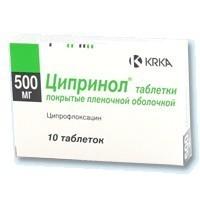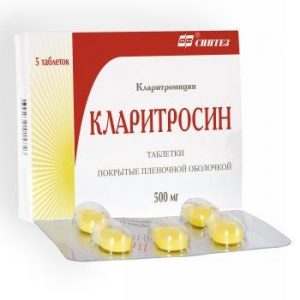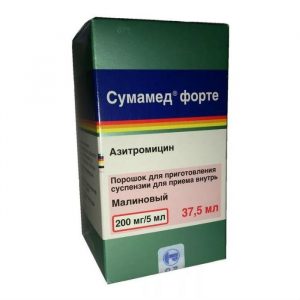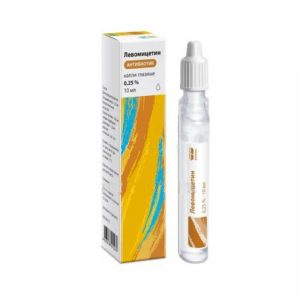Description
Release form
tablets.
Packing
10 pcs.
Pharmacological action
Broad-spectrum antimicrobial agent from the group of fluoroquinolones. It is bactericidal. The drug inhibits the bacterial DNA gyrase enzyme, as a result of which DNA replication and the synthesis of bacterial cellular proteins are disrupted. Low toxicity to macroorganism cells is explained by the lack of DNA gyrase in them. While taking ciprofloxacin, there is no parallel development of resistance to other antibiotics that do not belong to the group of gyrase inhibitors, which makes it highly effective against bacteria that are resistant, for example to aminoglycosides, penicillins, cephalosporins, tetracyclines and many other antibiotics. Ciprofloxacin acts on both multiplying microorganisms and those in the dormant phase. Gram-negative aerobic bacteria are susceptible to ciprofloxacin: enterobacteria (Escherichia coli, Salmonella spp., Shigella spp., Citrobacter spp., Klebsiella spp., Enterobacter spp., Proteus mirabilis, Proteus vulgaris, Serratia marcescens tpparaffaria, Haffa. , Morganella morganii, Vibrio spp., Yersinia spp.), Other gram-negative bacteria (Haemophilus spp., Pseudomonas aeruginosa, Moraxella catarrhalis, Aeromonas spp., Pasteurella multocida, Plesiomonas shigelloides, Campyuni lebella bufferii , Brucella spp., Chlamydia trachomatis, Listeria monocytogenes, Mycobacterium tuberculosis, Mycobacterium kansasii, Mycobacterium avium (located intracellularly).
Gram-positive aerobic bacteria are also sensitive to ciprofloxacin: Staphylococcus spp. (Staphylococcus aureus, Staphylococcus haemolyticus, Staphylococcus hominis, Staphylococcus saprophyticus), Streptococcus spp. (Streptococcus pyogenes, Streptococcus agalactiae). Most methicillin-resistant staphylococci are also resistant to ciprofloxacin.
The sensitivity of bacteria Streptococcus pneumoniae, Enterococcus faecalis is moderate. Corynebacterium spp., Bacteroides fragilis, Pseudomonas cepacia, Pseudomonas maltophilia, Ureaplasma urealyticum, Clostridium difficile, Nocardia asteroides are resistant to the drug. The effect of the drug on Treponema pallidum is not well understood. Like in vitro in vivo, Bacillus anthracis is also sensitive to ciprofloxacin.
Indications
Infectious and inflammatory diseases caused by microorganisms sensitive to ciprofloxacin: respiratory tract: pneumonia (except pneumococcal pneumonia), acute bronchitis and exacerbation of chronic bronchitis, bronchiectasis, cystic fibrosis, if there is a pathogen especially Pseudomonas aeruginosa)
ear, throat and nose: acute otitis media, sinusitis, mastoiditis
of the kidneys and urinary tract: uncomplicated and complicated infections of the lower and upper urinary tract (urethritis, cystitis, pyelonephritis) of small organ epididymitis , prostatitis, salpingitis, endometritis, oophoritis, tubular abscess and pelvioperitonitis, gonorrhea, mild chancre, chlamydia)
abdominal organs: intraperitoneal abscess cholecystitis, cholangitis (in combination with metronidazole or clindamycin), infectious diarrhea: with almonellosis, campylobacteriosis, yersiniosis, shigellosis, cholera, typhoid fever, travelers diarrhea, Salmonella typhi bacteriocarrier.
skin and soft tissue: infected ulcers, infected wounds, abscesses, phlegmon, infections of the external auditory canal, infected burns of the
musculoskeletal system: osteomyelitis, septic arthritis
Infections in patients with reduced immunity (during therapy with immunosuppressants or in patients with neutropenia).
Prevention of infections during surgical interventions (urological, gastrointestinal (in combination with metronidazole) and orthopedic).
Prevention and treatment of pulmonary anthrax.
Pediatric use
Ciprofloxacin is not recommended for use in children under 18 years of age for the treatment of other infectious diseases, except for the treatment and prevention of anthrax (after suspected or proven infection of Bacillus anthracis)
therapy of complications caused by Pseudomonas aeruginosa in children with pulmonary cystic fibrosis 5 under 17 years old.
Contraindications
Hypersensitivity to ciprofloxacin or other quinolone drugs or any other component of the drug.
Pregnancy and lactation.
Children and adolescents under 18 years of age (except for the treatment of complications, caused by Pseudomonas aeruginosa in children with pulmonary cystic fibrosis in children from 5 to 17 years of prevention and treatment of pulmonary anthrax)
Concomitant use with tizanidine (risk of pronounced decrease in blood pressure (BP), drowsiness).
Caution, severe cerebral arteriosclerosis, cerebrovascular accident, mental illness, epileptic syndrome, epilepsy, severe renal and / or liver failure, advanced age, glucose-6-dehydrogenase deficiency, glucocorticosteroid therapy.
Special instructions
If severe and prolonged diarrhea occurs during or after treatment with ciprofloxacin, the diagnosis of pseudomembranous colitis should be excluded which requires immediate withdrawal of the drug and the appointment of appropriate treatment. If there are pains in the tendons or when the first signs of tendovaginitis appear, treatment should be discontinued due to the fact that isolated cases (mainly in elderly patients who are simultaneously receiving glucocorticosteroids) of inflammation and even tendon rupture during treatment with fluoroquinolones have been described. During ciprofloxacin therapy, it is recommended to avoid excessive physical exertion.
During the period of treatment with ciprofloxacin, in order to avoid the development of crystalluria, the recommended daily dose should not be exceeded. It is also necessary to ensure the intake of a sufficient amount of fluid (under the control of diuresis) to maintain normal diuresis and maintain an acidic urine reaction. During treatment with ciprofloxacin, UV radiation (including contact with direct sunlight) should be avoided.
During therapy, an increase in the prothrombin index is possible (during surgical interventions, the condition of the blood coagulation system should be monitored).
In patients with glucose-6-dehydrogenase deficiency, the administration of ciprinol may cause hemolytic anemia. Patients should not drink alcohol during treatment.
Impact on the ability to drive vehicles and other mechanisms
Patients taking ciprofloxacin should be careful when driving a car and engaging in other potentially dangerous activities that require increased attention and speed of psychomotor reactions (especially while consuming alcohol).
Composition
1 tablet contains:
CORE:
Active ingredient:
ciprofloxacin in the form of ciprofloxacin hydrochloride monohydrate 582 mg. (which corresponds to ciprofloxacin – 500 mg).
Excipients: microcrystalline cellulose, sodium carboxymethyl starch (type A), povidone, croscarmellose sodium, anhydrous colloidal silicon dioxide, magnesium stearate.
SHELL:
hypromellose, talc, titanium dioxide, E171, propylene glycol.
Side effects of the digestive system: nausea, diarrhea, vomiting, abdominal pain, flatulence, anorexia, cholestatic jaundice (especially in patients with liver disease), hepatitis, hepatonecrosis.
From the central and peripheral nervous system: dizziness, headache, fatigue, agitation, convulsions, anxiety, tremor, insomnia, Nightmare dreams, peripheral paralgesia (anomaly in the perception of a feeling of pain), sweating, increased intracranial pressure, confusion, depression, hallucinations, as well as other manifestations of psychotic reactions (occasionally progressing to conditions in which the patient can harm himself, with suicidal tendencies ), migraine.
On the part of the sensory organs: impaired taste and smell, visual impairment (diplopia, color perception), tinnitus, hearing loss.
From the cardiovascular system: tachycardia, cardiac arrhythmias, decreased blood pressure (BP), fainting, sweating, a sensation of flushing of blood to the face, thrombosis of cerebral arteries.
From the hematopoietic system: leukopenia, granulocytopenia, anemia, thrombocytopenia, leukocytosis, thrombocytosis, hemolytic anemia.
From the urinary system: hematuria, crystalluria (primarily with alkaline urine and low diuresis), glomerulonephritis, dysuria, polyuria, urinary retention, albuminuria, urethral bleeding, decreased kidney excretory function, interstitial nephritis.
Allergic reactions: pruritus, urticaria, the formation of blisters accompanied by bleeding and small nodules forming scabs, drug fever, spot hemorrhages (petechiae), swelling of the face or larynx, shortness of breath, eosinophilia, vasculitis, exanthema, erythema nodosum, erythema erythema, ecotema Stevens-Johnson syndrome (malignant exudative erythema), toxic epidermal necrolysis (Lyell syndrome), anaphylactic shock.
From the musculoskeletal system: arthralgia, arthritis, tendovaginitis, tendon rupture, myalgia, swelling in the joint.
Other: general weakness, superinfection (candidiasis, pseudomembranous colitis), increased photosensitivity
From the laboratory parameters: hypoprothrombinemia, increased activity of hepatic transaminases and alkaline phosphatase, hypercreatininemia, hyperbilirubinemia, hyperuricemia,
Drug interaction
With the simultaneous use of ciprofloxacin with didanosine, the absorption of ciprofloxacin is reduced due to the formation of complexes of ciprofloxacin with aluminum and magnesium salts contained in didanosine. Due to a decrease in the activity of microsomal oxidation processes in hepatocytes, it increases the concentration and lengthens the half-life of theophylline and / or caffeine (and other xanthines), oral hypoglycemic drugs (glibenclamide – which can lead to hypoglycemia), indirect anticoagulants, and helps to reduce the prothrombin index.
Ciprofloxacin increases Cmax by 7 times (from 4 to 21 times) and AUC by 10 times (from 6 to 24 times) of tizanidine, which increases the risk of a pronounced decrease in blood pressure and drowsiness. Concomitant use with non-steroidal anti-inflammatory drugs (excluding acetylsalicylic acid) – increases the risk of seizures. The simultaneous administration of antacids, sucralfate, as well as preparations containing aluminum, zinc, calcium, iron or magnesium ions, can cause a decrease in the absorption of ciprofloxacin, therefore, the interval between the administration of these drugs should be at least 4 hours.
the effect of cyclosporin (it is necessary to control the level of blood creatinine 2 times a week).
Concomitant use of ciprofloxacin and glucocorticosteroids may increase the risk of tendon rupture.
The concurrent administration of ciprofloxacin and phenytoin may increase or decrease the serum concentration of phenytoin.
Metoclopramide accelerates the absorption of ciprofloxacin, which leads to a decrease in the time to reach its maximum plasma concentration. Co-administration of uricosuric drugs leads to a slowdown in elimination (up to 50%) and an increase in the plasma concentration of ciprofloxacin. When combined with other antimicrobials (beta-lactams, aminoglycosides, clindamycin, metronidazole), synergism is usually observed: the drug can be successfully used in combination with azlocillin and ceftazidime for infections caused by Pseudomonas spp. with meslocillin, azlocillin and other beta-lactam antibiotics – for streptococcal infections with isoxazolylpenicillins and vancomycin – for staph infections with metronidazole and clindamycin – for anaerobic infections.
Overdose
Symptoms: nausea, vomiting, diarrhea, headache and dizziness, and in more severe cases, confusion, tremors, hallucinations and convulsions.
Treatment: symptomatic, gastric lavage, the appointment of activated charcoal and laxatives to ensure sufficient fluid intake. The specific antidote is unknown. Hemodialysis does not have a clinical effect in intoxication.
Storage conditions
Store in a dry, dark place at a temperature not exceeding 25 ° C. Keep out of reach of children.
Expiration
5 years.
active substance
Ciprofloxacin
lekarstvennaja form
tablets
KRKA d.d. Novo mesto AO, Slovenia




